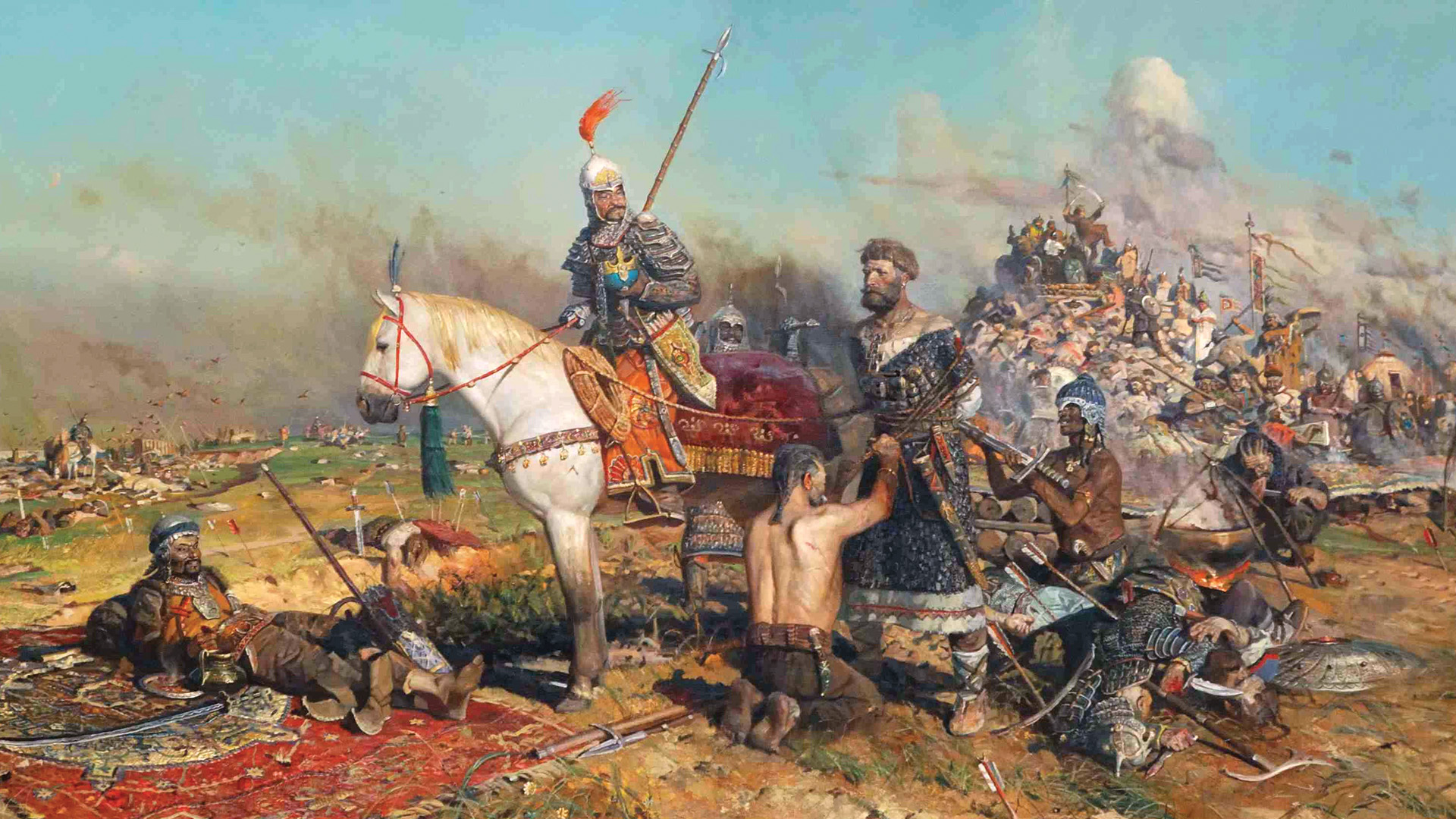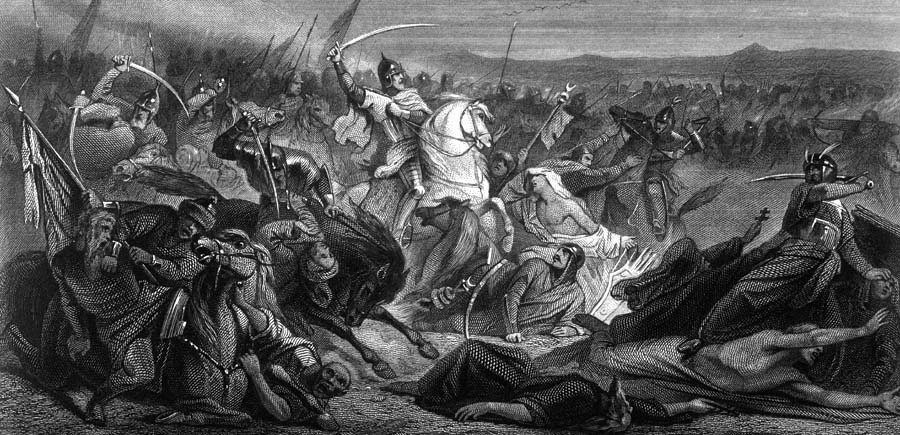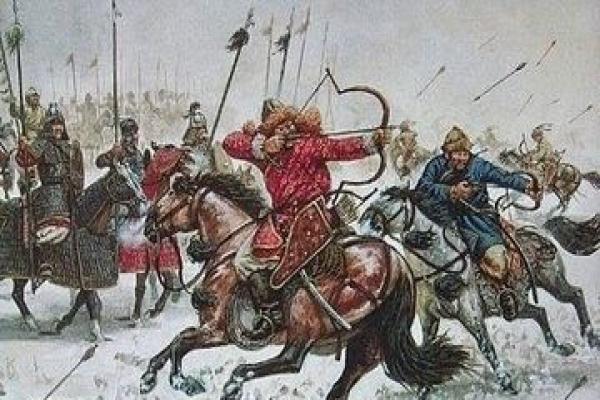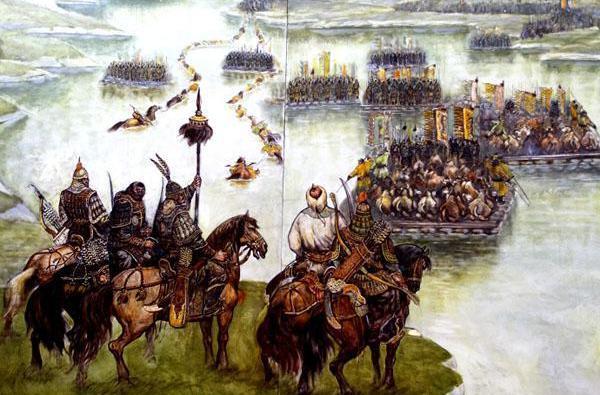. .
.
..Yaƙin Kogin Kalka a 1381 an yi yaƙi tsakanin Mongol Sun Mamaai da TOQTamish don ikon sarrafa zinare. Torctamiya ta kasance mai nasara kuma ta zama shugaba na hannun. Mamai a baya ya mallaki ikon da duk da haka ikon sa ya fara murƙushe lokacin da TOQTAMISH na farin Horde ya mamaye. A lokaci guda manyan manyan manyan sun tayar da adawa da Mongol, cire tushen kudin shiga na haraji daga Mamai. Mamai ta mamaye Rus amma an sha kashi a sanannen yakin Kulikovo. A halin da ake ciki a cikin gabas ya kwace babban birnin zinare na Horde, Saraya babban birnin Horde na Horde,. MAMI ya yi amfani da sauran kudin sa don ta daukaka karamar runduna kuma haduwa da TOQTAMISH a yankin da ke kewayen yankin arewacin Donets da Kalkya koguna da Kalkya koguna da Kalkya koguna da Kalkya koguna. Babu cikakkun bayanai game da yaƙin ya kasance amma ga zuwa ga zuwa ga zuwa ga zuwa ga zuwa ga Torqtamiya, wanda mai yiwuwa yana da sojoji mafi girma, ya sami nasara nasara. Daga baya ya ci gaba da zinare..

Setting the Stage: The Overview
The Battle of Kalka River unfolded against the backdrop of an expanding Mongol Empire, led by the fearless commanders Jebe and Subutai. This Mongol juggernaut had already carved an empire across Asia, but now it cast its gaze westward, hungry for more conquests. On the other side stood an uneasy alliance of the Kievan Rus’ and Cumans, their collective strength pitted against the relentless Mongol war machine.
.
蒙古西征迦勒迦河之戰.Battle of the Kalka River(俄語:Битва на реке Калке,烏克蘭語:Битва на річці Калка,蒙古語:Калка голын тулалдаан)是指西元1223年欽察人及基輔羅斯對抗蒙古的戰爭。
自鐵木真成為大汗後,蒙古開始東征西討,因此居於第聶伯河的欽察人向基輔羅
斯的加利奇公國求助(因欽察人曾包庇蔑兒乞人)。由於兩國存在姻親關係,加利奇決定聯合其他羅斯的公國對抗蒙古,合組成8萬大軍。
負責統率蒙古軍的哲別及速不台,駐守在第聶伯河的下游支流卡利奇克河(或譯卡爾卡河)按兵不動。 加利奇的王公姆斯季斯拉夫按捺不住,率兵渡河發動進攻。蒙古軍則向後佯撤,引誘加利奇軍脫離大軍;直到卡利奇克河平原之時,姆斯季斯拉夫才發覺己軍被整齊的蒙古軍分割得七零八落又求助無援。其實當時羅斯其他的大公已經趕到戰場,但因利害關係著想而不願投入戰場。
姆斯季斯拉夫最終逃離戰場回到卡利奇克河的對岸,臨走前還燒毀了所有的船隻,結果不但使蒙古軍無法繼續追趕,連其他羅斯軍隊亦無路可逃,通通成為了蒙古的戰俘。
.
Mongol Invasion of Europe: The March Westward
The Mongols were not content with their vast Asian conquests; they sought to expand into Europe. The Battle of Kalka River marked their initial foray into European territories, and it was a harbinger of more to come. The Mongols, under the brilliant leadership of Jebe and Subutai, used the battle as a testing ground for their tactics, setting the stage for further incursions into Eastern Europe..

 .Mongol invasion of Georgia and Battle of Khunan in 1221.
.Mongol invasion of Georgia and Battle of Khunan in 1221.
The Battle of the Kalka River[c] was fought between the Mongol Empire, whose armies were led by Jebe and Subutai, and a coalition of several Rus principalities, including Kiev and Galicia-Volhynia, and the Cumans under Köten. They were under the joint command of Mstislav the Bold and Mstislav III of Kiev. The battle was fought on May 31, 1223 on the banks of the Kalka River in present-day Donetsk Oblast, Ukraine, and ended in a decisive Mongol victory.
Following the Mongol invasion of Central Asia and the subsequent collapse of the Khwarezmian Empire, a Mongol force under the command of prominent Mongol Noyans (generals) Jebe and Subutai advanced into Iraq-i Ajam. Jebe requested permission from the Mongol emperor, Genghis Khan, to continue his conquests for a few years before returning to the main army via the Caucasus. While waiting for Genghis Khans reply, the duo set out on a raid in which they attacked the Kingdom of Georgia. Genghis Khan granted the duo permission to undertake their expedition, and after making their way through the Caucasus, they defeated a coalition of Caucasian tribes before defeating the Cumans. The Cuman Khan fled to the court of his son-in-law, Mstislav Mstislavich of Galicia, whom he convinced to help fight the Mongols. Mstislav the Bold formed an alliance of the Rus princes including Mstislav III of Kiev.
The combined Rus army defeated the Mongol rearguard at first. The Rus pursued the Mongols, who were in a feigned retreat, for several days, which spread out their armies. The Mongols stopped and assumed battle formation on the banks of the Kalka River. Mstislav the Bold and his Cuman allies attacked the Mongols without waiting for the rest of the Rus army and were defeated. In the ensuing confusion, several other Rus princes were defeated, and Mstislav of Kiev was forced to retreat to a fortified camp. After holding out for three days, he surrendered in return for a promise of safe conduct for himself and his men. Once they surrendered, however, the Mongols slaughtered them and executed Mstislav of Kiev. Mstislav the Bold escaped, and the Mongols went back to Asia, where they joined Genghis Khan.
Background
In 1219, in retaliation for the murders of his ambassadors,] the Mongol Khan, Genghis Khan, invaded the Khwarezmian Empire.] In a campaign that lasted three years, Genghis Khan and his generals destroyed the Khwarezmian armies and caused the empire to disintegrate. The Khwarezmian Sultan Ala ad-Din Muhammad succumbed to disease on an island in the Caspian Sea, leaving his son, Jalal al-Din Mangburni landless.[
When Jebe (one of the Mongol generals pursuing Muhammad) heard of Ala ad-Din Muhammads death, he asked Genghis Khan for a year or two to continue his conquests before returning to Mongolia via the Caucasus.]
While awaiting Genghis reply, Jebe and Subutai (another general pursuing Muhammad) led their army of 20,000 men, with each general commanding a tumen. They left behind a trail of destruction as they moved through Persian Iraq (Iraq-i Ajam) and Azerbaijan, sacking the cities of Rey, Zanjan and Qazvin. The city of Hamadan surrendered without a struggle. Meanwhile, Özbeg, the Atabeg of Azerbaijan, saved his capital, Tabriz, and prevented his countrys destruction by offering to the Mongols a large amount of money, clothing and horses, which were the Mongols best weapons.]
From Tabriz, the Mongols advanced north and made their winter base in the Mugan Steppes. There, the army was strengthened by the arrival of Kurdish and Turcoman freebooters, who offered their services to the Mongols.]
1381年的迦勒迦河之戰,是欽察汗國兩位蒙古軍閥馬麥與脫脫迷失為控制汗國進行的的戰爭,最後脫脫迷失勝利,把金帳與白帳統一起來。
馬麥是事實上統治欽察汗國的權臣(儘管他從未稱汗),但是當白帳汗國的脫脫迷失入侵時,他的控制權就開始瓦解。同時,羅斯王公反抗蒙古統治,從瑪麥帶走了寶貴的稅收來源。後來馬麥入侵了羅斯,但在著名的庫里科沃之戰中被擊敗。
後來出身白帳的脫脫迷失從東面入侵攻佔首都薩萊,馬麥用剩下的錢湊合了一支小部隊,並在北頓涅茨河遭遇脫脫迷失的軍隊,戰鬥的細節沒有剩下,但可能擁有一支更大部隊的脫脫迷失贏得了決定性的勝利,隨後他接管汗國(馬麥逃亡至克里米亞時,被卡法的熱那亞人殺死)。
..

..The number of men present at the battle is disputed. A major factor in this is the fact that no primary sources give the number of men present at the battle, which leaves modern historians to estimate the number of men. Historian Leo de Hartog gives the size of the Rus army as 30,000,] while Richard Gabriel and Hector Hugh Munro claim that the size of the Rus army was 80,000.[] De Hartog also estimates the size of the Mongol army as 20,000, while Gabriel estimates that it was around 23,000 men.] However, historian John Fennell, an expert on Kievan Rus and early Russian history, and one well-versed in the primary sources, calls many of these figures into doubt, saying the numbers given in the Russian sources (there are no Mongol or Polovtsian sources, at least none that have survived, and other sources from other cultures, if they exist, are rather dubious) are formulaic or exaggerated and the chronicles contradict themselves.[] The information given in the Novgorod First Chronicle and the Primary Chronicle would imply a total of 11,000 soldiers for the Rus forces, but Fennel considers even these numbers to be exaggerations.[] While Russian historians in the Soviet era have traditionally given estimates of around 80,000-100,000, modern Russian historians have taken a revisionist stance with a consensus settling on drastically lower numbers, with the Mongols having a numerical advantage.] Russian historian D.G. Khrustalev estimated in 2013 that the Rus army consisted of 10,000 soldiers (including mercenaries), while the Cumans brought 5,000 cavalry, for a total of 15,000.[] Carl Sverdrup estimates the army at 8,000, and says 30,000 and 80,000 are enormous exaggerations.[] The Mongols evidently believed it was a considerable force, given the extreme lengths the Mongols went to to dislocate its formations.[
The move by the Rus army was detected by the Mongols, who were on the east side of the Dnieper River waiting for reinforcements from Jochi, Genghis Khans eldest son, who was campaigning around the Aral Sea. Jochi, however, had become ill, which meant no reinforcements would be coming.[]
At the same time, the Rus attempted to trap the Mongols. The princes of Galicia and Volhynia transported their armies south down the river, while the princes of Kiev and Chernigov advanced north up the river, and the army of Kursk advanced from the front. At the same time, the Cumans attempted to attack the Mongol armys rear.[29] When Jebe learned of this, he sent 10 envoys to the Prince of Kiev. The envoys stated that the Mongols had no feud with the Rus and were only attacking the Cumans; they added that the Mongols were marching east, away from the Rus cities. Mstislav of Kiev had the envoys executed, and the Mongols responded by sending another set of ambassadors, who declared war.[]
When Jebe and Subutai heard of the Rus movements, they began moving east, away from the Rus, which was the only direction in which they could move. However, they left a rearguard of 1,000 under the command of an officer, Hamabek, to report of the Rus movements and act as bait. Soon, Mstislav the Bold reached the river opposite the rearguard, and it became apparent that no prince had been appointed commander-in-chief. Thus, all the princes could act as they pleased. Eventually, Mstislav crossed the river under heavy arrow fire. When the Rus landed, however, their numbers were too great, and the Mongols were killed to the last man.]
After drawing out the Rus armies for nine days in a feigned retreat, the Mongol army turned to face their pursuers along the Kalka River (the rivers location is currently unknown, but it is thought to be the Kalchyk which flows into the Sea of Azov).[33]
The Russian primary sources give only a very general account of the battle itself and the pursuit of the princes back across the steppe. The chronicles name which princes took part and which died, but not much more in terms of the size of armies or casualties. As to the actual battle itself, the chronicles report that the Polovtsy (Cumans) broke and ran without having fought and that their flight through the Rus’ ranks led to mass confusion and resulted in their slaughter by the Mongols.[]
Rus defeat:
The Mongols attacked the coalition army when most of it had crossed the Kalka River. The Mongols appear to have caught the coalition forces by surprise in a fast transition from horse archer fire to massed cavalry charges, because the coalition rout began incredibly quickly: the Rus forces bringing up the rear had not yet arrived on the battlefield by the time the front ranks were dissolving. The armies of Volhynia and Kursk made a gap in their line so that the fleeing Cumans could retreat. However, the Mongol heavy cavalry charged through the newly formed gap and also enveloped them. The army of Chernigov, which was not aware that the battle had started, was advancing when they collided head-on with the retreating Cumans. Using smoke bombs to disrupt the coalitions ability to coordinate, the Mongol cavalry took advantage of the confusion in the Chernigov line and attacked, causing the line to collapse. This, in turn, led to the death of Prince Mstislav of Chernigov]
At the same time, the Mongol wings closed around the shattered Rus army, cutting off its retreat. The surrounded Rus were hit by volley after volley, accompanied by cavalry charges at any weakness in the formation. As the Mongols were carrying this annihilation out, some of the army – led by Mstislav the Bold – managed to cut their way through the Mongol ring and escape.] Mstislav of Kiev arrived to see what remained of the Rus army fleeing. With his contingent of 10,000 men, he retreated to his stockaded camp, on a hill by the Dnieper. The pursuing Mongol army caught up with Mstislav of Kievs forces and started to besiege the camp.[
..歐洲的種裝甲騎兵 好看不實際.無法發生有關效果的戰鬥力
迦勒迦河之戰,蒙古軍隊大穫全勝,以機動迅速,迂迴曲折的包抄,及假裝逃亡的戰略及戰術短時期內擊敗敵軍..由歷史學者專家根據當時戰爭時期的畫像,可以瞭解到,歐洲基輔羅.絲等邦聯的軍隊裝束,都是厚重的鎧甲,不利於長途奔跑作戰,而且行動緩慢,不利於用力量揮舞刀劍,長矛或是射箭戰術等動作,尤其是近身搏鬥與蒙古騎兵交戰不出30分鐘,就力不從心無法發揮戰鬥力,相反的蒙古軍隊裝束輕甲冑,毛皮包裹身體行動自如,即使夜間雪地區,荒郊野外作戰,沒有有火爐等取暖,照樣不畏寒冷的低溫,但是基輔導羅斯及歐洲的軍隊,過半數都是重裝甲騎兵,白天有太陽照射,運動作戰鎧甲金屬吸熱,士兵猶如攜帶來火爐作戰,不舒服無法散熱,即使卸下鎧假亦需要他人員協助,在夜間氣溫迅速下降,鎧甲急速冷卻又快,又無法戰場生火取暖,暴露目標容易被偷襲,經過迦勒迦河之戰,蒙古軍隊得到相當的野外戰爭的經驗了解到如何對抗歐洲的重裝甲騎兵,日後蒙古第二次西征確實對歐洲聯軍造成了巨大的打擊,並在1241年的萊格尼察戰役和蒂薩河之戰中取得大勝。 這場戰爭(1237-1242年)由拔都領導,成功征服了俄羅斯,波蘭,匈牙利,日耳曼等多個國家的重裝甲奇兵.前後的戰爭累積下來共約60 萬歐洲軍隊被蒙古軍隊消滅.,日後筆者蒐集整理資料向讀者們報導蒙古第二次西征的故事..




.


1222年,由哲別、速不台率領的蒙古軍隊越過高加索山,進入欽察草原,並對生活於此地的庫曼人發起攻擊。遭到蒙軍擊敗的庫曼汗國可汗忽灘(Köten)於是逃往基輔,請求女婿加利奇王公「大膽的」姆斯季斯拉夫二世‧姆斯季斯拉維奇(Mstislav II Mstislavich the Daring)出兵相助。

加利奇王公姆斯季斯拉夫二世‧姆斯季斯拉維奇在接獲岳父忽灘的乞援之後,迅速召集羅斯諸王公討論應對之策。與會者除了加利奇王公姆斯季斯拉夫二世‧姆斯季斯拉維奇外,還有南羅斯最主要王公:基輔大公「老」姆斯季斯拉夫三世‧羅曼諾維奇(Mstislav III Romanovich the Old)、車爾尼戈夫王公姆斯季斯拉夫二世‧斯維亞托斯拉維奇(Mstislav II Svyatoslavich)、彼列索普尼茨克王公「寡言」姆斯季斯拉夫‧雅羅斯拉維奇(Mstyslav Yaroslavich Nemoy)與加利西亞-沃里尼亞國王丹尼洛‧羅曼諾維奇(Danylo Romanovych),及其他羅斯王公與會。羅斯王公們為了是否援助庫曼人而爭論不休,最終在加利奇王公姆斯季斯拉夫二世‧姆斯季斯拉維奇積極活動下,與會王公同意組成反蒙聯軍。
加利奇王公姆斯季斯拉夫二世‧姆斯季斯拉維奇也曾試圖拉攏弗拉基米爾-蘇茲達爾大公尤里二世‧弗謝沃洛多維奇(Yuri II Vsevolodovich)加盟,然最終因為弗拉基米爾-蘇茲達爾大公尤里二世‧弗謝沃洛多維奇過去曾多此與加利奇王公姆斯季斯拉夫二世‧姆斯季斯拉維奇爭奪諾夫哥羅德共和國的王公大位,因此結下樑子,弗拉基米爾-蘇茲達爾大公尤里二世‧弗謝沃洛多維奇於是沒有參與盟約。

1223年5月中,基輔大公「老」姆斯季斯拉夫三世‧羅曼諾維奇、加利奇王公姆斯季斯拉夫二世‧姆斯季斯拉維奇、車爾尼戈夫王公姆斯季斯拉夫二世‧斯維亞托斯拉維奇、加利西亞-沃里尼亞國王丹尼洛‧羅曼諾維奇等羅斯王公率部進援庫曼汗國可汗忽灘,準備迎戰蒙軍。蒙軍得知羅斯諸公國已派軍援助庫曼汗國,因此派遣使者,試圖阻止羅斯人,以分化羅斯-庫曼聯軍。然而,羅斯王公們並未被說動,而是將來使斬殺,表示堅決的抵制意志。哲別見羅斯諸王公不願屈服,便又遣使,譴責羅斯王公們擅殺來使,並批評他們輕信庫曼人的挑撥。羅斯王公們見蒙軍兩度派遣使者,便認定蒙古人是因為手頭兵力很少,無力與之抗衡,因此才會一再前來求和,於是便對蒙軍懷有輕視之心,於是便放走了第二批使節。

雖然羅斯諸王公之間對於共同對抗蒙古人毫無疑義,但加利奇王公姆斯季斯拉夫二世‧姆斯季斯拉維奇與基輔大公姆斯季斯拉夫三世‧羅曼諾維奇在如何對抗蒙古人卻產生了分歧,這使得羅斯軍隊的行動喪失一致性。
由於羅斯軍隊在初次與蒙軍交鋒時,很快地就將蒙軍逐退,因而使得加利奇王公姆斯季斯拉夫二世‧姆斯季斯拉維奇更加確信蒙軍不堪一擊,為了獨享勝利的榮耀,加利奇王公姆斯季斯拉夫二世‧姆斯季斯拉維奇便率領本部兵馬會同加利西亞-沃里尼亞國王丹尼洛‧羅曼諾維奇及忽灘的庫曼軍對蒙軍發起追擊,搶先渡過聶伯河。蒙古軍繼續佯裝敗退,誘敵深入。其他羅斯王公也不甘落後地率部跟進。蒙軍則一再示弱,讓羅斯聯軍深信蒙古人並非他們的敵手。羅斯軍隊一連追擊八日,大軍便遠離了羅斯本土,深入迦勒迦河畔。羅斯軍隊再次取勝,輕敵的加利奇王公姆斯季斯拉夫二世‧姆斯季斯拉維奇決心一舉追殲蒙古軍隊,便在沒有通知其他盟軍的情況下,與一直採取共同行動的加利西亞-沃里尼亞國王丹尼洛‧羅曼諾維奇與庫曼汗國可汗忽灘搶先對蒙軍發動攻擊。
此時哲別、速不台見羅斯聯軍已被誘離羅斯本土,且軍隊也因追擊而被拉開,於是便抓準加利奇王公姆斯季斯拉夫二世‧姆斯季斯拉維奇冒進的機會,打算一舉解決羅斯聯軍各部。1223年6月16日,加利奇王公姆斯季斯拉夫二世‧姆斯季斯拉維奇率部向蒙軍發起衝鋒,這次蒙軍不再退卻,反而主動迎擊,雙方因此展開激戰,衝在軍隊最前頭的加利西亞-沃里尼亞國王丹尼洛‧羅曼諾維奇在戰鬥中胸部受傷,但仍堅持不退出戰局,可是與之一同行動的庫曼軍卻無力抵抗蒙軍的反撲,因而潰散而去。潰敗的庫曼騎兵在退卻時,打算後緊隨在後的羅斯步兵,這使得羅斯軍隊陷於混亂之中,蒙軍立即發起進擊,將羅斯軍隊切割、包圍,車爾尼戈夫王公姆斯季斯拉夫二世‧斯維亞托斯拉維奇在混戰中陣亡。

此時,羅斯其他王公也陸續抵達戰場,基輔大公姆斯季斯拉夫三世‧羅曼諾維奇眼見加利奇王公姆斯季斯拉夫二世‧姆斯季斯拉維奇的敗局已定,因此決定袖手旁觀,自率部隊在迦勒迦河畔立陣。待加利奇王公姆斯季斯拉夫二世‧姆斯季斯拉維奇大部遭到擊敗後,蒙軍便將主要打擊目標轉向基輔大公姆斯季斯拉夫三世‧羅曼諾維奇。蒙軍很快地就將基輔大公姆斯季斯拉夫三世‧羅曼諾維奇的陣地團團包圍,基輔大公姆斯季斯拉夫三世‧羅曼諾維奇只得死命堅守陣地。與此同時,加利奇王公姆斯季斯拉夫二世‧姆斯季斯拉維奇則率領殘部突圍,臨走前為免蒙古軍追擊,下令將所有船隻燒燬,其他羅斯軍隊也因此被斷了後路。經過三天的激戰後,彈盡援絕的基輔大公姆斯季斯拉夫三世‧羅曼諾維奇相信了蒙古人允諾將會讓他與其軍隊安然退去,於是放下武器向蒙軍投降。
.
然而,蒙古人卻毀棄了諾言,放下武器的羅斯軍隊全部遭到屠殺,以基輔大公姆斯季斯拉夫三世‧羅曼諾維奇為首的羅斯諸王公也全部遭到絞死。加利奇王公姆斯季斯拉夫二世‧姆斯季斯拉維奇則幸運逃回羅斯,原本弗拉基米爾-蘇茲達爾大公尤里二世‧弗謝沃洛多維奇派出援軍打算支援,但當援軍才剛抵達車爾尼哥夫便得知敗訊後,弗拉基米爾軍便折回本國。戰後,哲別、速不台轉向襲擊伏爾加保加爾人,遭到伏爾加保加利亞國王加布杜拉‧切爾比爾(Ghabdula Chelbir)擊敗,於是蒙軍便因此收兵東返。





 .
.





























